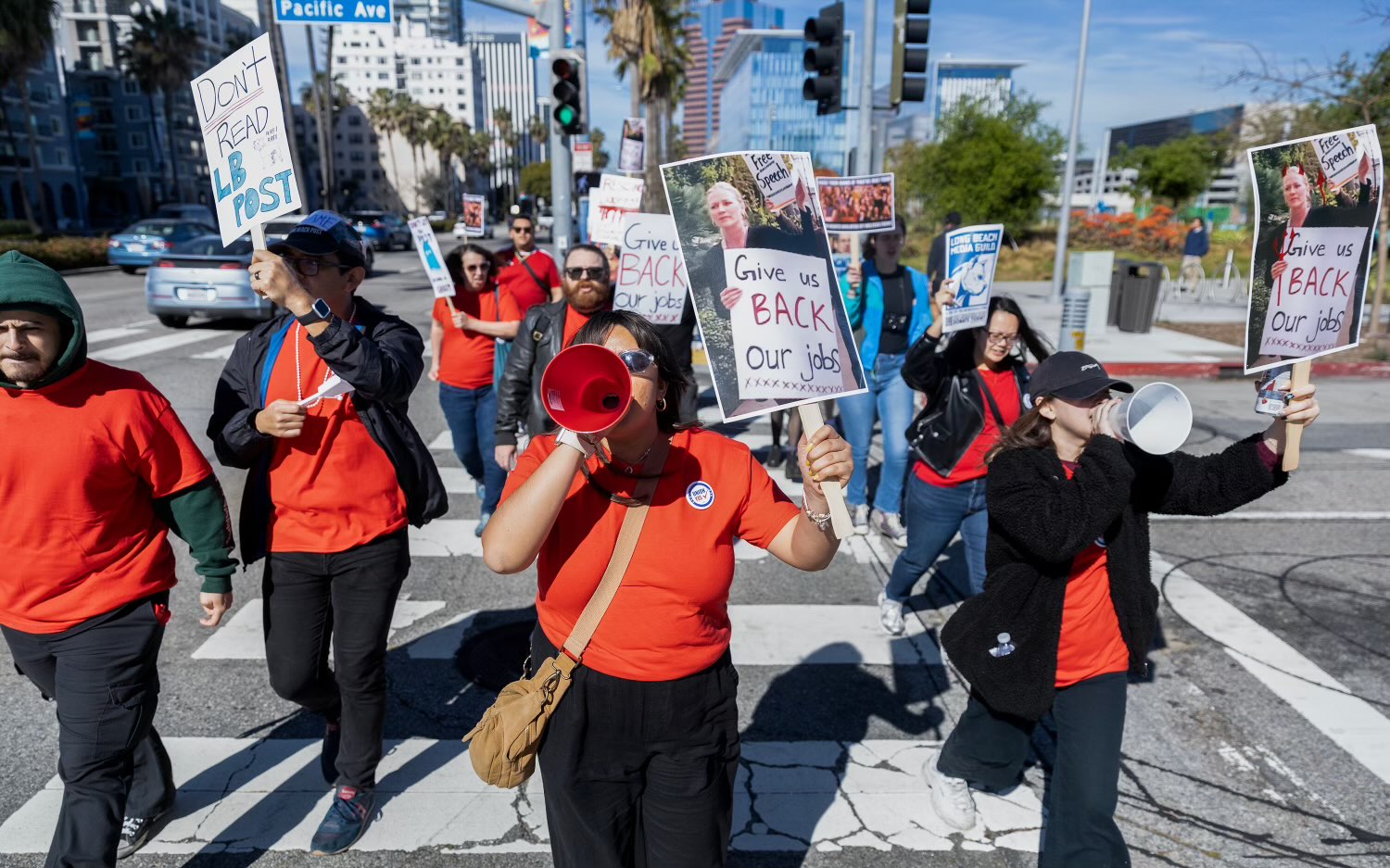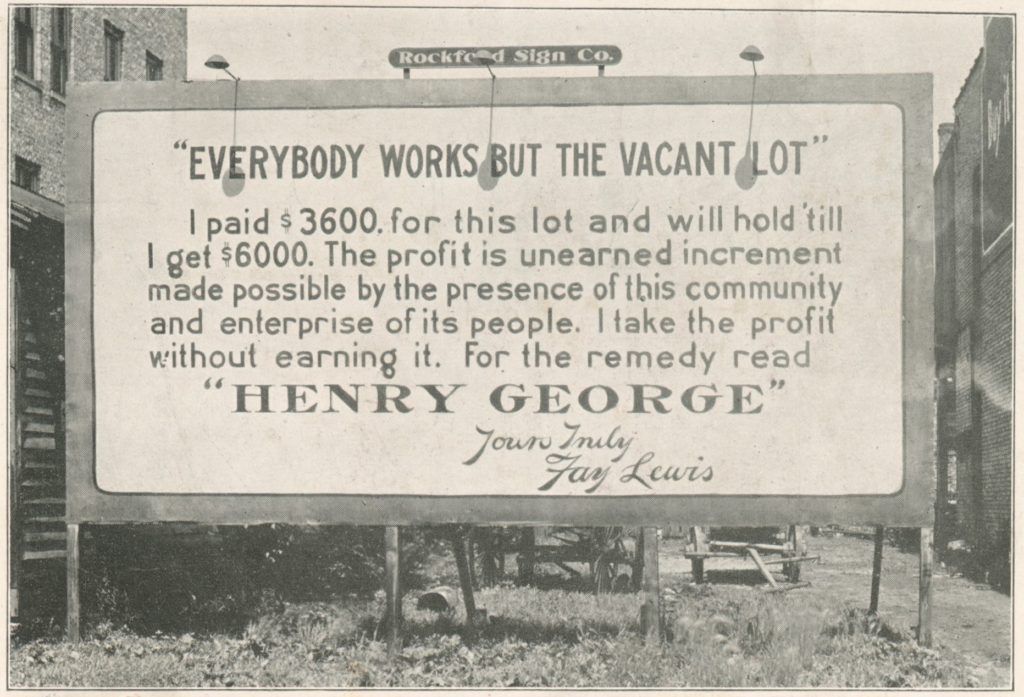Accusations of Union Busting and Mismanagement Beset the Long Beach Post as Layoffs Decimate Newly Formed Nonprofit Newsroom
17 minute readThe mood was uneasy when staff members of the Long Beach Post and Long Beach Business Journal gathered for an all-hands meeting with CEO Melissa Evans on March 21. Tensions between leadership and the newsroom had been mounting for months, as accusations of labor violations and mismanagement had surfaced amid growing concerns that the organization was, financially, a sinking ship.
It had been a little over three months since the publications had reorganized under a nonprofit, separating from previous owner Pacific6 Enterprises, the investment firm of local venture capitalist and developer John Molina. For the last six years, Pacific6 had largely been floating the operation, the city’s only daily digital news outlet, which grew to become the biggest local newsroom.
During the afternoon meeting, staff presented Evans with a union recognition form. In turn, Evans pointed to a graph illustrating the looming budget cliff and confirmed what had long been dreaded by staff members: the paper was going broke and another round of layoffs would start the following day.
The news was met with a peppering of questions from staffers about financial decisions leadership had made since December: Why had Evans been given a raise? Why were they sitting in a $6,000-a-month downtown office?
“I knew that this was gonna be a tough meeting. Obviously, it has been devastating hearing that there are complaints about me personally because I love them all. I still do,” Evans said in an interview. “I’m proud of myself. I mean, you know, this is what comes as part of the job.”
After half an hour of going back and forth, Jason Ruiz, the Post’s longest-serving reporter, had heard enough. He stood up to leave.
“I invited her to look around the room and see if she saw bar graphs that she was about to lay off or if she saw people’s faces,” Ruiz said.
Before walking out, he turned to Evans and reminded her how the newsroom had stood by her during difficult times in the past, such as when Molina threatened her job last year over a story about the Convention Center’s finances. (Molina declined to comment for this article.)
Then the rest of the staff followed Ruiz out the door, emptying the office. They have not returned since that day, forcing the Post’s website to become a gallery of wire copy and rehashed police press releases. Ruiz, who was not one of the employees on the chopping block, said he and the two other reporters still on staff remain on strike in solidarity with their former colleagues.
“We recognize there’s a financial issue as with all newspapers,” he said. “The main point of what we’re trying to do is we’re trying to save this goddamn paper.”
That night, former and striking staff members drafted a proposal that included pay cuts, reduced hours, and even furloughs as an effort to save jobs. They sent it off to Evans and the three-person board of directors, but the bosses did not budge.
“I sent a message to the board asking if they would like to consider this. I waited until I heard back from the majority, and the consensus was that we needed to proceed with the planned cuts immediately given our urgent cash flow issues,” Evans said.
The next morning, nine staff members received calls informing them that they had been let go. There would be no severance pay and their health insurance would lapse by the end of the week. These latest cuts followed a round of layoffs last fall when the organization began transitioning to a nonprofit. What had been a staff of 26 in August was reduced to 17 in October and now stands at only eight. Of those, only three are full-time reporters with a visuals editor, executive editor, and fellow rounding out the newsroom.
The layoffs are a major blow to Long Beach, the second largest city in the nation’s most populous county—a city that regularly ranks among the most diverse in the country. It’s a city with an annual budget of over $3 billion. It’s no secret that even before these layoffs there were not nearly enough journalists to provide the coverage the city needs. Now there’s even less.
The Columbia Journalism Review has pointed to academic studies showing how the ongoing local news collapse happening around the country has likely led to lower voter turnout and bond ratings, and more corruption, waste, air pollution, and corporate crime.
Laura Anaya-Morga, who led the Post’s Spanish-language coverage, and Jackie Rae, the Post’s only Black journalist, were among those who have been let go since October. After the police murder of George Floyd in Minneapolis in May 2020, many outlets invested in covering marginalized communities. But in the spate of drastic layoffs that have hit the media industry in the last year, journalists of color, especially women of color, have been the ones to be disproportionately cut, undoing much of the diversity newsrooms gained.
Currently the @LongBeachPost has no Black reporters focused on covering the Black community, & none covering the Latino/Spanish speaking community. If representation doesn’t matter, your dollar shouldn’t either. Don’t spend money with organizations that don’t value diversity!
— Jackie Rae (@JackieRaeTV) March 22, 2024
Mayor Rex Richardson on Tuesday released a statement saying he was “deeply concerned” by the layoffs and ongoing labor dispute.
“The situation absolutely sucks,” said Cal State Long Beach journalism professor and LBJI board member Gwen Shaffer.
How did the Post get here?
The Long Beach Post has a complicated history, to say the least.
It was founded in 2007 by former Mayor Robert Garcia and business consultant Shaun Lumachi as a blog for local boosterism and political commentary. In 2013, the Post was fully moved under the ownership of future City Council member Cindy Allen’s ad agency, ETA Advertising. Molina’s Pacific6 bought the Post in 2018 and the Business Journal in 2020, consolidating the two newsrooms. He became one in a line of wealthy men who scooped up media organizations in the last decade with lofty promises of saving the news.
“We need to create a new model for local journalism. The sort of old model where it’s a newspaper and you sell ads doesn’t appear to be sustainable,” Molina said at the time.
He joined Dr. Patrick Soon-Shiong, a biotechnology and start-up billionaire, who purchased The LA Times in 2018 for $500 million. But instead of profits, the billionaires and millionaires were unable to turn the businesses around, finding a bottomless pit of losses. In January, The Times laid off 115 employees.
“I would just say every owner at some point gets tired of losing money,” Evans said. “When John Molina bought the Post, he had always said there was a three- to five-year runway. And we were at that five-year mark.”
Under the ownership of Pacific6, the newsroom worked out of a $14,000-a-month office on Ocean Boulevard as the number of staff swelled to an all-time high. The publications ramped up their social media presence, started a community editorial board, and launched a weekly podcast. But the growth proved to be unsustainable.
“John Molina was having some financial issues of his own that I’m not at liberty to go into,” Rae, who had been the host of The Word podcast, said in a recent interview with Jerlene Tatum, a local political commentator. “That made the Long Beach Post problematic for him and it was something he wanted to cut ties to because he simply couldn’t afford it anymore.”
Knowing that Pacific6 was itching to scratch the media organization off its balance sheet, Evans says in August she approached the corporate bosses with the idea of spinning off the Long Beach Post and Business Journal into an independent nonprofit, which was eventually dubbed the Long Beach Journalism Initiative (LBJI). She was given the greenlight.
Mario Molina, head of Molina Healthcare and John Molina’s brother, agreed to put up $100,000 in seed money, according to state charity registration documents filed by the newly formed nonprofit last year. According to those documents, $40,000 of Mario Molina’s grant went toward wages with another $45,000 earmarked for programmatic expenses, listed as “overhead and freelance costs, subscription fees, publication and technology costs for community newsroom.”
“Since then it’s just been a hustle,” said Evans. “Ideally, if you’re going to do this, I learned, you should probably give yourself about a year to fundraise first. And then, you know, figure out how to do it so that you’re not building a ship as you’re sailing it through a storm. But unfortunately, we do not have that luxury.”
The storm soon turned into a flood of untenable bills and broken promises. Evans said she prepared the organization’s initial budget based on half a million dollars worth of donations that had been verbally promised to her. But some of those major donations failed to materialize, creating big holes in the budget.
“I don’t know how to explain it, except to say they just didn’t come. I did everything I could to follow up and follow up,” Evans said. She declined to identify what donors reneged on their pledges, saying only that it was “multiple donors.”
In documents filed with the Internal Revenue Service, the nonprofit projected a budget of about $1.6 million for 2024, nearly 90% of which would go toward salaries and wages.
But by February, it became clear to Evans and the board that those projections would not be met.
“The Post’s monthly expenses were triple the amount of revenue being generated and most of the budget went to salaries. You don’t need to be a math whiz to understand how unsustainable that is,” Shaffer said. “The facts are that the Post had about one month of operating revenue remaining (optimistically two) without significant staff reductions. So the options were to dissolve the paper at the end of April, or lay off staff now and try to rebuild.”
A full-time accountant was hired to replace the one that had been working on a volunteer basis. After cycling through multiple scenarios with the new accounting firm, Evans says she arrived at the conclusion that layoffs were the only option forward and informed the board and staff of the proposed cuts on Feb. 28.
“That was hard. You know, the hardest thing is you don’t want to come in as a manager and just one day start laying people off. I’ve had that happen before. And it’s crummy. You want to be transparent, but at the same time that carries risks, like, then people are left with anxiety,” she said.
Striking and former staff members contend that Evans have not taken enough responsibility for the “gross mismanagement” that contributed to the organization’s dire financial straits, such as building a budget based on money that was only informally promised rather than cash on hand and accounts receivable.
Tomisin Oluwole
Face the Music, 2022
Acrylic on canvas
24 x 36 inches
Click here to check out our interview with Tomisin Oluwole, a literary and visual artist based in Long Beach.

Instead of gunking up our site with ads, we use this space to display and promote the work of local artists.
“Before all this, there was a leadership circle, so all of the managers kind of decided things democratically. But after Melissa put herself forward as CEO, that structure changed. And the managers who used to be able to chime in and be part of the decision-making process were systematically frozen out of any kind of substantial discussion about how the business is operated,” said Ruiz.
Evans says the board of directors, who she appointed, were charged with “overseeing the big picture,” while she handled the day-to-day decisions.
Another bad money move, former and striking staff say, was the unilateral decision by Evans to sign a $6,000-a-month lease in early December for an office space on Broadway and Pine Avenue. During the transition phase, staff had been working from home.
“We were working remotely and we were putting out the same amount of work, if not more, than when we had an office,” said Brandon Richardson, a Long Beach Business Journal reporter who was laid off.
Evans says she stands by her decision to sign the lease.
“Having an office is a good thing for business, especially when we need to raise money. We need to host people, we want to be able to have events, we want to have people in the office. And it’s also just good for camaraderie. And it’s better for the news process to have a place where we all gather,” she said.
The nonprofit’s registration documents filed with the IRS show $92,400 budgeted for rent and utilities this year, an amount that would have covered the cost of the lease had the organization met its revenue projections.
Evans also caught flak for a $10,000 raise she received at the beginning of December, which bumped up her annual salary to $100,000. When the nonprofit formed, she went from being the executive editor to CEO, a job that brought with it “significantly more responsibility and work,” she said.
“I think you will find my salary is on the low end of what a typical CEO would make,” she said, adding that the raise came before the organization found itself in financial trouble. “Others on staff also received upward pay adjustments as their duties changed within the new organization.”
However, Shaffer, said the “financial trouble was well-known since last Fall.” A follow-up email asking why the board approved the raise anyway was not returned by press time.
Ruiz said any pay bumps given to newsroom employees were only done so to stay in compliance with the state raising the minimum wage and salary at the beginning of the year. He added that Evans never offered to take a pay cut in an effort to save jobs, contradicting a previous statement that she and the board made saying they “took every measure to avoid cutting jobs.”
“It’s a lie, because nothing was tried,” Ruiz said.
For her part, Evans admits that she may have been in over her head in the CEO role.
“I’m an editor and reporter, you know what I mean. I’m figuring this out as I go,” she said. “I’m grateful for this experience and its taught me a whole different side of the journalism business. It’s been an educational experience, that’s for sure.”
Accusations of Retaliation and Wage Theft
Two weeks prior to the momentous meeting in March that ended in a walk out, newsroom staff had sent a letter to the nonprofit’s board of directors outlining a litany of concerns with management.
Among the complaints were that staff had been coerced into working without pay for nine days in November while employees were off-boarded from the old company and onboarded to the nonprofit.
“[Evans] made it very clear that, you know, anybody who didn’t volunteer, didn’t have to be offered a job going forward. We were forced to work for a few weeks unpaid, under the threat of not being rehired by the nonprofit,” Ruiz said.
Two former employees we spoke to corroborated this claim. Former editor Kat Schuster, who was one of the nine employees laid off last week, says management openly told staff that severance pay from the previous company could be used to offset the unpaid wages.
Evans denies these accusations and says she merely asked staff in an onboarding memo to volunteer only if they wanted to.
“At no time did I threaten anyone’s job if they did not work,” she said.
But Schuster says Evans sent the memo after multiple employees raised concerns about the legal liability that could arise from coercing employees to work for free.
An outside HR firm hired by the board of directors to handle the grievances in the letter quickly advised Evans to pay employees for the nine unpaid days. Evans said that checks for back pay went out this week.
“That was a big chunk of money, and we simply could not afford it,” she said.
Another allegation in the letter was that staff members had been misclassified as exempt employees, which meant that some did not get overtime pay even when working overtime hours.
Schuster says Evans told her about the issue in December but never did anything to correct it.
“It’s just another example of Melissa willfully and knowingly breaking labor laws,” Brandon Richardson said.
Evans did not confirm or deny whether any employees were misclassified, saying only that there was an ongoing investigation by the outside HR form that “we hope to have wrapped up very soon.”
The inaction from the board became the catalyst for the formation of the Long Beach Media Guild, a unit of the NewsGuild CWA, which was publicly announced on March 15. All 14 of the eligible staff members signed union cards, Ruiz said. So far, the union has not been recognized by management.
“I think that they need to recognize the union and come to the negotiating table because if not I don’t know how the Post survives past April,” Ruiz said.
Schuster and Brandon Richardson allege that they were laid off in retaliation for being heavily involved in the unionizing effort. Schuster says she was directly told by management that her job would be spared. Neither of their names appeared on a layoff list that was leaked to staff by a sympathetic member of leadership in early March. And yet, they got the ax on March 22. Meanwhile, they say a staff member who had been on the leaked layoff list but later decided to stop participating in the unionizing effort was kept onboard.
Evans calls the allegations of union busting and retaliation “absolutely false” instead saying her decisions were based on journalistic priorities and preserving the organization’s core product.
“I don’t have a problem at all with the idea of a union, but I was a little concerned that they were using it to stall or stop the layoffs. Which I knew we couldn’t do. We just couldn’t do it,” Evans said. “My goal with all of this is to make a sustainable organization so that we can build on this base.”
Shaffer also called the accusations of retaliation “false,” saying that staff were told about the possibility of layoffs prior to the unionization effort.
However, former and striking staff members said the board of directors had informed employees that layoffs would be put on ice until the conclusion of the HR investigation. But to date, they say, no one on staff has been contacted by the HR firm about their grievances despite the layoffs moving forward.
Media Guild of the West filed an unfair labor practice claim with the National Labor Relations Board against the LBJI on March 22 alleging that at least some of the layoffs were in retaliation for participating in union organizing.
The Long Beach Media Guild is demanding that the layoffs be rescinded and that the board voluntarily recognize the union.
A union vote has been scheduled for April 5. In the meantime, the Long Beach Media Guild has set up a strike fund, which has so far raised over $9,700. Guild members are urging people not not to click on any Long Beach Post or Business Journal links and not to engage with the publications on social media while the strike is ongoing.


 kevin@forthe.org
kevin@forthe.org @reporterkflores
@reporterkflores




